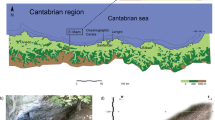Abstract
Estimation of the isotopic turnover rate in the tissues of organisms allows us to estimate the temporal relationship between the isotope ratio of an organism and its prey, and to analyze seasonal variations of food webs and migratory patterns of animals. We analyzed the isotopic turnover rate in the tissue of lacustrine sockeye salmon, Oncorhynchus nerka, of three age classes in a laboratory food alteration experiment to clarify the isotopic turnover rate. The contribution of growth to isotopic turnover was higher in young and fast-growing lacustrine sockeye salmon than in older and slow-growing fish. Maturation masks the relationship between the contributions of growth and metabolism to isotopic change. Our estimate of the isotopic time lag of lacustrine sockeye salmon can be used to research trophic relationships of anadromous sockeye salmon.
Similar content being viewed by others
References
E.G. Bligh W.J. Dyer (1959) ArticleTitleA rapid method of total lipid extraction and purification Can. J. Biochem. Physiol. 37 911–917 Occurrence Handle1:CAS:528:DyaG1MXhtVSgt70%3D
J.R. Brett (1965) ArticleTitleThe relation of size to rate of oxygen consumption and sustained swimming speed of sockeye salmon (Oncorhynchus nerka) J. Fish. Res. Board Can. 22 1491–1501
J.R. Brett (1971) ArticleTitleEnergetic responses of salmon to temperature.A study of some thermal relations in the physiology and freshwater ecology of sockeye salmon (Oncorhynchus nerka). Am. Zool. 11 99–113
T.K. Frazer R.M. Ross L.B. Quetin J.P. Montoya (1997) ArticleTitleTurnover of carbon and nitrogen during growth of larval krill, Euphausia superbaDana: a stable isotope approach J. Exp. Mar. Biol. Ecol. 212 259–275
C.J. Harvey P.C. Hanson T.E. Essington P.B. Brown J.F. Kitchell. (2002) ArticleTitleUsing bioenergetics models to predict stable isotope ratio in fishes Can. J. Fish. Aquat. Sci. 59 115–124
S.Z. Herzka G.J. Holt (2000) ArticleTitleChanges in isotopic composition of red drum (Sciaenops ocellatus) larvae in response to dietary shifts: potential applications to settlement studies Can. J. Fish. Aquat. Sci. 57 137–147
R.H. Hesslein K.A. Hallard P. Ramlal (1993) ArticleTitleReplacement of sulfur, carbon, and nitrogen in tissue of growing broad whitefish (Coregonus nasus) in response to a change in diet traced by δ 34S, δ13C, and δ15N Can. J. Fish. Aquat. Sci. 50 2071–2076 Occurrence Handle10.1139/f93-230 Occurrence Handle1:CAS:528:DyaK2cXktVOqs7o%3D
K.A. Hobson R.G. Clark (1992) ArticleTitleAssessing avian diets using stable isotopes I: turnover of 13C tissues Condor 94 181–188
K. Iida T. Mukai (1995) ArticleTitleBehavior of kokanee Oncorhynchus nerka in Lake Kuttara observed by echo sounder Fish. Sci. 61 641–646 Occurrence Handle1:CAS:528:DyaK2MXot1Wrurs%3D
J.R. Keough C.A. Hagley E. Ruzycki M. Sierszen (1998) ArticleTitle δ13C composition of primary producers and role of detritus in a freshwater coastal ecosystem Limnol. Oceanogr. 43 734–740 Occurrence Handle1:CAS:528:DyaK1cXlsFWqtr4%3D Occurrence Handle10.4319/lo.1998.43.4.0734
S.E. MacAvoy S.A. Macko G.C. Garman (2001) ArticleTitleIsotopic turnover in aquatic predators: quantifying the exploitation of migratory prey Can. J. Fish. Aquat. Sci. 56 923–932
A. Maruyama Y. Yamada B. Rusuwa M. Yuma (2001) ArticleTitleChange in stable nitrogen isotope ration in the muscle tissue of a migratory goby, Rhinogobiussp., in a natural setting Can. J. Fish. Aquat. Sci. 58 2125–2128
I.D. McCarthy E. Moksness D.A. Pavlov D.F. Houlihan (1999) ArticleTitleEffects of water temperature on protein synthesis and protein growth in juvenile Atlantic wolffish(Anarhichas lupus) Can. J. Fish. Aquat. Sci. 56 231–241 Occurrence Handle1:CAS:528:DyaK1MXivFSrtLs%3D
K. Oelbermann S. Scheu (2002) ArticleTitleStable isotope enrichment ( δ15N and δ13C) in a generalist predator( Pardosa lugubris, Araneae: Lycosidae): effect of prey quality Oecologia 130 337–344
C.M. O’Reilly R.E. Hecky (2002) ArticleTitleInterpreting stable isotopes in food webs: recognizing the role of time averaging at different trophic levels Limnol. Oceanogr. 47 306–309 Occurrence Handle1:CAS:528:DC%2BD38XhtlSqsbY%3D Occurrence Handle10.4319/lo.2002.47.1.0306
N.C. Overman D.L. Parrish (2001) ArticleTitleStable isotope composition of walleye: δ15N accumulation with age and area-specific differences in δ13C Can. J. Fish. Aquat. Sci. 58 1253–1260
L. Persson S. Diehl L. Johansson G. Andersson S.F. Hamrin (1992) ArticleTitleTrophic interactions in temperate lake ecosystems: a test of food chain theory Am. Nat. 140 59–84
D.M. Post (2002) ArticleTitleUsing stable isotopes to estimate trophic position: models, methods, and assumptions Ecology 83 703–718 Occurrence Handle10.1890/0012-9658(2002)083[0703:USITET]2.0.CO;2
Sakano, H., S. Ban, M. Kaeriyama, H. Ueda & K. Shimazaki. 2001. The interaction between lacustrine sockeye salmon (Oncorhynchus nerka )and pond smelt (Hypomesus nipponensis ) in relation to the decline of zooplankton biomass in Lake Toya, northern Japan. pp. 3881–3885. In : W.D. Williams (ed.), Proceedings of the 27th Congress of the International Association of Theoretical and Applied Limnology, Dublin, Ireland.
N. Takamura H. Mikami H. Mizutani K. Nagasaki (1999) ArticleTitleDid a drastic change in fish species from kokanee to pond smelt decrease the secchi disc transparency in the oligotrophic Lake Towada, Japan Archiv für Hydrobiologie 144 283–304
L.L. Tieszen T.W. Boutton K.G. Tesdahl N.A. Slade (1983) ArticleTitleFractionation and turnover of stable carbon isotopes in animal tissues: implications for δ13C analysis of diet Oecologia 57 32–37 Occurrence Handle10.1007/BF00379558
M.J. Vander Zanden M. Hulshof M.S. Ridgway J.B. Rasmussen (1998) ArticleTitleApplication of stable isotope techniques to trophic studies of age-0 smallmouth bass Trans. Am. Fish. Soc. 127 729–739
M.J. Vander Zanden J.M. Casselman J.B. Rasmussen (1999a) ArticleTitleStable isotope evidence for the food web consequences of species invasions in lakes Nature 401 464–467 Occurrence Handle1:CAS:528:DyaK1MXmslyru78%3D
M.J. Vander Zanden B.J. Shuter N. Lester J.B. Rasmussen (1999b) ArticleTitlePatterns of food chain length in lakes: a stable isotope study Am. Nat. 154 406–416
K. Yoshii N.G. Melnik O.A. Timoshkin N.A. Bondarenko P.N. Anoshko T. Yoshioka E. Wada (1999) ArticleTitleStable isotope analyses of the pelagic food web in Lake Baikal Limnol. Oceanogr. 44 502–511 Occurrence Handle10.4319/lo.1999.44.3.0502
Author information
Authors and Affiliations
Corresponding author
Rights and permissions
About this article
Cite this article
Sakano, H., Fujiwara, E., Nohara, S. et al. Estimation of nitrogen stable isotope turnover rate of Oncorhynchus nerka . Environ Biol Fish 72, 13–18 (2005). https://doi.org/10.1007/s10641-004-4187-4
Received:
Accepted:
Issue Date:
DOI: https://doi.org/10.1007/s10641-004-4187-4




